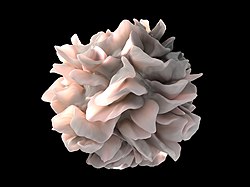
Back خلية متغصنة Arabic Dendritska ćelija BS Cèl·lula dendrítica Catalan Dendritická buňka Czech Dendritcelle Danish Dendritische Zelle German Dendrita ĉelo Esperanto Célula dendrítica Spanish Dendriitrakk Estonian Zelula dendritiko Basque
| Dendritic cell | |
|---|---|
 Dendritic cells in skin | |
 Artistic rendering of the surface of a human dendritic cell illustrating sheet-like processes that fold back onto the membrane surface. Some researchers believe that these sheets, when exposed to HIV, entrap viruses in the vicinity and focus them to contact zones with T cells targeted for infection. These studies were carried out using ion abrasion scanning electron microscopy, a new[when?] technology the NIH has been developing and applying for 3D cellular imaging. | |
| Details | |
| System | Immune system |
| Identifiers | |
| Latin | cellula dendritiformis |
| MeSH | D003713 |
| TH | H1.00.01.0.00038 |
| FMA | 83036 |
| Anatomical terminology | |
A dendritic cell (DC) is an antigen-presenting cell (also known as an accessory cell) of the mammalian immune system. A DC's main function is to process antigen material and present it on the cell surface to the T cells of the immune system. They act as messengers between the innate and adaptive immune systems.[1]
Dendritic cells are present in tissues that are in contact with the body's external environment, such as the skin (where there is a specialized dendritic cell type called the Langerhans cell), and the inner lining of the nose, lungs, stomach and intestines. They can also be found in an immature and mature state in the blood. Once activated, they migrate to the lymph nodes, where they interact with T cells and B cells to initiate and shape the adaptive immune response. At certain development stages they grow branched projections, the dendrites, that give the cell its name (δένδρον or déndron being Greek for 'tree'). While similar in appearance to the dendrites of neurons, these are structures distinct from them. Immature dendritic cells are also called veiled cells, as they possess large cytoplasmic 'veils' rather than dendrites.[citation needed]
- ^ Monga I, Kaur K, Dhanda S (March 2022). "Revisiting hematopoiesis: applications of the bulk and single-cell transcriptomics dissecting transcriptional heterogeneity in hematopoietic stem cells". Briefings in Functional Genomics. 21 (3): 159–176. doi:10.1093/bfgp/elac002. PMID 35265979.